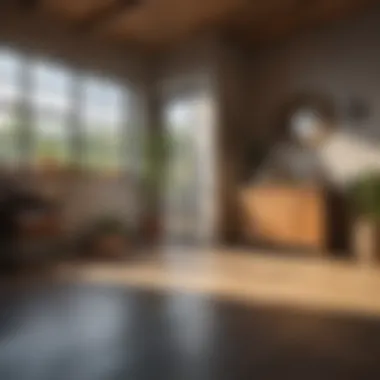Ammonia and Vinegar: Natural Rat Repellent Solutions


Intro
In the realm of pest management, the presence of rats poses a noteworthy challenge. These rodents can infiltrate living spaces and gardens, causing damage and health risks. This article addresses a particular approach to deterring these pests—utilizing ammonia and vinegar as potential repellents. Together, we will explore their effectiveness, chemical properties, and eco-friendly implications, offering practical strategies for homeowners and gardeners.
Understanding Pests
Definition of Pests
Pests are organisms, often insects or rodents, that cause harm or nuisance to humans, crops, and livestock. This includes rats, which can invade homes, contaminate food, and transmit diseases. Identifying pests accurately is crucial for effective control measures. Misidentification can lead to ineffective solutions and unnecessary expenditure.
Importance of Pest Identification
Identifying specific types of pests allows individuals to implement targeted strategies. For example, different rodent species may respond differently to ammonia and vinegar. Knowing whether one is dealing with Norway rats or roof rats aids in deploying the right methods for management. Proper identification also helps assess the level of infestation and select suitable preventative measures.
Prevention Techniques
Home and Garden Preventative Measures
Successfully keeping rats at bay requires a combination of methods.
- Seal Entry Points: Inspect the foundation, windows, and doors for gaps. Seal these openings with steel wool or caulk to prevent rats from entering.
- Maintain Cleanliness: Regularly clean areas where food is stored and eliminate remnants that attract pests.
- Proper Storage: Use airtight containers for food storage. This limits the rats' access to potential food sources.
Seasonal Prevention Tips
Rats tend to seek shelter indoors during colder months. Seasonal changes necessitate adapting preventive measures:
- In autumn, clear out leaves and debris from gardens, as these can provide nesting materials.
- During spring, inspect gardens for new entry points that may have emerged during winter thawing.
Eco-Friendly Pest Control Solutions
Overview of Sustainable Practices
Sustainability is increasingly important in pest control. Homeowners are turning to eco-friendly solutions that minimize chemical exposure. Ammonia and vinegar are two options gaining popularity due to their non-toxic properties.
Natural Remedies and Their Effectiveness
Natural remedies such as ammonia and vinegar show promise. Their efficacy stems from their strong odors, which can act as irritants for rats. Application methods can vary:
- Dilution: Mix ammonia with water in a spray bottle and apply in areas frequented by rats.
- Vinegar Use: Spray undiluted vinegar around entry points. Its acidic nature may deter rodents.
"Utilizing natural repellents is a proactive approach to managing rat populations while safeguarding health and the environment."
Prelude to Rat Issues in Domestic Spaces
Rats pose a significant challenge in many domestic environments. Their presence can result in a variety of problems, including health risks, property damage, and the spread of diseases. Understanding the nuances of rat infestations is critical for homeowners, as these pests can multiply rapidly and create a formidable presence if not addressed effectively. This article seeks to dissect the efficacy of ammonia and vinegar as potential repellents, exploring their chemical properties and practical applications.
Understanding Rat Behavior and Habitats
Rats are highly adaptable creatures, often living in close proximity to humans. They thrive in urban settings where food and shelter are abundant. Understanding their behavior offers insights into preventing and managing infestations. Rats typically seek dark, quiet places such as basements, attics, and burrows near buildings. Notably, they are nocturnal, which means they are mainly active during the night. This behavior complicates detection and control efforts. Homeowners can significantly benefit from knowing common entry points and habits of rats.
The Importance of Effective Pest Control
Effective pest control is crucial for maintaining a healthy living space. Employing comprehensive strategies ensures that rat populations are kept under control, minimizing the risks associated with infestations. The importance of this topic extends beyond mere comfort; it has implications for safety and hygiene. For instance, rats can gnaw on electrical wires, leading to fire hazards, or contaminate food supplies, which can lead to serious health issues. Thus, exploring non-toxic and eco-friendly methods, such as ammonia and vinegar, can provide homeowners with effective alternatives in their pest management arsenal.
Chemical Properties of Common Household Ingredients
Understanding the chemical properties of common household ingredients is essential for evaluating their efficacy as rat repellents. Ingredients such as ammonia and vinegar are not only ubiquitous but also possess unique characteristics that can influence their performance in pest management. This section will offer insight into these components, focusing on how their distinct properties contribute to their effectiveness in repelling rats. Additionally, it will examine considerations for safe use and overall household safety.


Vinegar: Composition and Characteristics
Vinegar is primarily composed of acetic acid, which usually makes up about 4% to 8% of the liquid. The remaining content includes water and trace amounts of other compounds. This simple structure allows vinegar to be an effective agent in various applications. Its strong odor acts as a natural deterrent for many pests, including rats, as their sense of smell is acute.
The acidity of vinegar also plays a role in its efficacy. A rat’s olfactory receptors can identify specific compounds, and the sharp scent of vinegar can irritate these receptors, creating an aversive experience. Thus, using vinegar as a repellent could lead to behavioral changes in rats, prompting them to avoid areas treated with this substance. Beyond its repellent qualities, vinegar is also valued for its versatility, being used in cooking and cleaning.
Ammonia: Understanding its Properties
Ammonia is a compound made of nitrogen and hydrogen, giving it a strong and pungent odor. Its concentration in household cleaning products typically ranges from 5% to 10%. This strong scent is what makes ammonia a potential deterrent for rats. The vapor can be overwhelming, which can provoke a flight response in rodents.
Ammonia's volatile nature also means that it evaporates quickly. This property can significantly limit its duration of efficacy. However, it is worth noting that its rapid evaporation can be an advantage in applying it to well-ventilated areas. Safety must be a primary concern when utilizing ammonia, as inhaling its fumes can harm both humans and pets. Proper ventilation during application is crucial to minimize health risks.
Mechanism of Ammonia and Vinegar as Repellents
Understanding the mechanism by which ammonia and vinegar deter rats is crucial for homeowners and gardeners seeking effective pest management strategies. Rats rely significantly on their senses of smell and taste to navigate and identify their environment. Both ammonia and vinegar possess strong odors that can interfere with these senses, ultimately making areas treated with these substances less inviting to these rodents.
By exploring how ammonia and vinegar work as repellents, we can underscore their potential effectiveness. These natural substances provide a cost-efficient and eco-friendly alternative to commercial pest control options. Understanding their mechanisms not only empowers individuals to make informed decisions but also promotes sustainable practices in pest control.
How Ammonia Interacts with Rat Senses
Ammonia is known for its sharp and pungent smell. When rats encounter ammonia, it can provoke an immediate aversive response. Their sensitive olfactory receptors make them highly reactive to strong odors. The scent of ammonia mimics a natural predator's smell and evokes a sense of danger.
Research indicates that when exposed to ammonia, rats may experience discomfort due to the high concentration of the chemical in the air. This discomfort can lead them to leave areas where ammonia is present. Moreover, ammonia's volatility means it can quickly dissipate, requiring careful reapplication to maintain its repellency.
When implementing ammonia as a deterrent, it is essential to consider a few practical elements:
- Dilution: Ammonia should be diluted with water for safer application. A mixture of one part ammonia to three parts water is often recommended.
- Location: Apply it strategically in areas where rat activity is observed.
- Frequency: Regularly reapply to ensure effectiveness, especially after rain or in damp conditions.
Vinegar's Impact on Rat Behavior
Vinegar, particularly white vinegar, produces a strong acetic acid odor that is not only unpleasant to humans but also to rodents. When vinegar is used in pest control, it acts by disrupting the normal foraging behavior of rats. The strong smell may deter rats from entering treated areas. This is particularly useful in gardens or indoor spaces where rats may seek food.
Vinegar's effectiveness can vary with concentration and application method. Higher concentrations may yield better results. Similar to ammonia, vinegar must be reapplied, especially in outdoor settings or high-traffic areas. To enhance its deterrent qualities, many homeowners mix vinegar with other ingredients, such as essential oils or citrus peels, further amplifying the repellent effect.
Key considerations for using vinegar include:
- Application Zones: Identify areas with high rat activity for focused treatment.
- Reapplication Schedule: Regularly refresh the application, especially after rain.
- Safety: While vinegar is less toxic than ammonia, it should still be handled with care, particularly around pets and children.
Overall, both ammonia and vinegar can play a vital role in managing rat populations. Understanding their mechanisms allows for better application and greater effectiveness in pest control efforts.
Application Techniques for Ammonia and Vinegar
Understanding the application techniques for ammonia and vinegar is crucial in maximizing their effectiveness as rat repellents. Proper methods of handling and using these substances can significantly influence their repellent qualities. Homeowners must consider both the safety aspects and effectiveness of these techniques to ensure they can manage pest situations effectively while maintaining a healthy environment.
Safe Handling and Preparation
When it comes to ammonia and vinegar, safe handling is paramount. Both substances are potent and can pose risks if not dealt with carefully. Here are some important safety considerations:
- Personal Protective Equipment (PPE): Always wear gloves, goggles, and a mask when handling ammonia and vinegar. This can help prevent skin irritation, eye damage, or respiratory issues.
- Ventilation: Ensure that the area is well ventilated. This helps to dissipate fumes and reduces inhalation risks, particularly when spraying the mixtures.
- Storage: Keep both substances in sealed containers and store them out of reach of children and pets. They should be kept in a cool, dry place to prevent any unpredictable reactions.
- Avoid Mixing: Never mix ammonia and vinegar directly. Doing so creates toxic chloramine vapors, which can be harmful. Use them separately in different areas as needed.
By adhering to these safety measures, homeowners can prepare their repellent mixtures without significant risks to their health or safety.
Effective Application Methods
Applying ammonia and vinegar effectively involves understanding the environments where rats are likely to enter or hide. Here are some methods to consider:
- Location Targeting: Focus on areas that rats frequent, such as entry points, gnawed areas, or hiding spots. Common locations include basement corners, under sinks, and near food sources.
- Spray Application:
- Soaked Rags or Cotton Balls: Soaking rags, cotton balls, or pads in ammonia or vinegar can serve as effective bait. Place these soaked items in strategic locations. Ensure they're not accessible to pets or children.
- Regular Reapplication: The effectiveness of these repellents can diminish over time due to environmental factors. Reapply them every few days or after rain to maintain their potency.
- For vinegar, dilute it with water in a spray bottle. A 50/50 solution of vinegar and water is often effective. Spray it liberally in identified areas where you suspect rat activity.
- For ammonia, mix it with water at a ratio of one part ammonia to ten parts water. This mixture can also be sprayed but be cautious of the odor.


"Proper application and regular maintenance of these methods can substantially increase the likelihood of deterring rats from your home."
These techniques offer homeowners practical and straightforward ways to use ammonia and vinegar effectively. By implementing these recommended practices, they can create an environment less inviting to rats.
Efficacy of Ammonia and Vinegar in Repelling Rats
Understanding the effectiveness of ammonia and vinegar as rat repellents is crucial for those seeking eco-friendly pest control solutions. These substances are readily available, inexpensive, and have been favored by many as alternatives to commercial repellents. This section will analyze the efficacy of these common household items in deterring rats, the benefits of using them, and key considerations that accompany their use.
Research Findings on Effectiveness
Research on the effectiveness of ammonia and vinegar reveals varying results, often depending on the specific application methods and contexts. Studies have indicated that the strong odors emitted by both ammonia and vinegar can deter rats and influence their movement within an area. Ammonia contains nitrogen compounds that give off a pungent smell, reminiscent of predators or animal urine, which can discourage rats from entering treated areas. Similarly, vinegar, particularly white vinegar, has a sharp scent that is often unappealing to rodents.
Several experiments conducted in controlled environments have shown that these substances can reduce rat activity significantly. For example, a study demonstrated a substantial decrease in rat presence in areas where vinegar-soaked rags were placed compared to untreated locations. However, the long-term reliability of these substances as repellents remains debated.
User Experiences and Case Studies
Many homeowners and gardeners have shared their experiences regarding the use of ammonia and vinegar in keeping rats at bay. User testimonials provide a wealth of insights into real-world effectiveness. A significant number of individuals report that placing small bowls of vinegar in strategic areas of the garden or near entry points of the home has created an unfavorable environment for these pests. Users often emphasize the importance of reapplying vinegar frequently to maintain its effectiveness.
In various online forums, such as Reddit and Facebook groups dedicated to pest management, people discuss both positive and negative outcomes. While some have found success with these household remedies, others have reported minimal results, particularly in the case of high infestations. Understanding these varied experiences can help potential users gauge the practical value of ammonia and vinegar as repellents before committing to their use.
"Using vinegar helped reduce the signs of rat activity, but I learned to combine it with other methods for the best results." - A common sentiment among users in pest management forums.
In summary, while ammonia and vinegar show promise, users should consider integrating these substances with other preventive measures to achieve better results in rat control.
Safety Considerations in Using Ammonia and Vinegar
When considering the use of ammonia and vinegar as rat repellents, it is crucial to address safety considerations. While both substances are common household items, improper use can lead to health risks for humans and pets. Understanding these risks ensures that individuals can implement these solutions effectively and without danger. Precautionary measures enhance the safety of the application while maximizing its effectiveness against rodent infestations.
Toxicity Risks to Humans and Pets
Ammonia, though effective as a repellent, presents specific toxicity risks. Exposure to ammonia vapors can cause irritation to the respiratory system, eyes, and skin. In environments with poor ventilation, high concentrations can lead to more severe effects. Pets, particularly cats, may be more sensitive to ammonia fumes, leading to respiratory distress or other health issues. It is essential to monitor the signs of discomfort in both humans and pets during application.
Vinegar, particularly white vinegar, is generally considered safe but can still pose some risks. Ingesting significant amounts may irritate the gastrointestinal tract. Furthermore, concentrated vinegar solutions can cause irritation to the skin and eyes. Therefore, keeping these substances out of reach of children and pets is necessary to prevent accidental poisoning or harm.
"Awareness of toxicity is vital when using household ingredients for pest control applications."
Preventative Measures During Application
To minimize the risks associated with ammonia and vinegar, certain preventative measures should be taken:
- Adequate Ventilation: Ensure the area is well-ventilated. Open windows and doors while applying these substances. It helps disperse the fumes and reduces the concentration in the air, decreasing the chance of inhalation.
- Protective Gear: Using gloves and masks can provide a barrier against skin absorption and inhalation of fumes. This simple precaution can enhance safety significantly.
- Proper Dilution: It is wise to dilute ammonia with water before application. This reduces its intensity and potential for harm. For vinegar, similarly, avoid concentrated solutions unless necessary.
- Application Timing: Choose times for application when children and pets are not in the vicinity. This simple step can significantly reduce exposure risk.
By taking these safety precautions, individuals can utilize ammonia and vinegar effectively as rodent repellents while safeguarding their health and that of their household. With a mindful approach to application, it is possible to benefit from these solutions without compromising safety.
Comparative Analysis: Ammonia and Vinegar vs. Commercial Repellents
In the exploration of pest control solutions, it is essential to consider the efficacy of inexpensive household ingredients like ammonia and vinegar against commercial repellent products. This comparative analysis helps in understanding the pros and cons of using DIY methods versus store-bought alternatives, particularly for household contexts.
Examining ammonia and vinegar reveals several benefits. These substances are eco-friendly, readily available, and significantly cheaper than many commercial repellents. Homeowners often prefer safer and more natural alternatives to maintain their homes. However, commercial repellents come with their own set of advantages, including specialized formulas designed for maximum effectiveness against a range of pests. The ingredients are often tested and verified by pest control professionals, providing in-depth insights into their efficiency and safety.
Effectiveness of Commercial Solutions
When evaluating the effectiveness, commercial repellents typically claim superior results when it comes to repelling rats. Many formulas contain essential oils like peppermint or synthetic chemicals that specifically target rodent behavior. These products frequently undergo rigorous testing and have established safety parameters.
Research has shown that many commercial options can effectively deter rats when used correctly. They offer a certain level of assurance for users who may be skeptical about the performance of natural solutions. However, the true efficacy often depends on various factors such as the concentration of the active ingredients and the method of application.
Cost and Accessibility Considerations
From a cost perspective, ammonia and vinegar are remarkably affordable. High-quality commercial repellents can range significantly in price, often exceeding thirty dollars for a single bottle. The accessibility of ammonia and vinegar cannot be overstated, as they are standard ingredients found in most households.


- Pros of Ammonia and Vinegar:
- Cons of Commercial Products:
- Low-cost solutions.
- Eco-friendly options.
- Easy to find at home or local stores.
- Higher price point.
- May contain chemicals that are undesirable.
- Complicated formulations that can overwhelm consumers.
A homeowner’s choice largely hinges on balancing costs and effectiveness. While commercial products present convenience and potential higher efficacy, the natural alternatives should not be overlooked for those looking to manage pests in a cost-effective and environmentally responsible manner.
Alternative Eco-Friendly Solutions for Pest Control
The increasing concern about environmental sustainability has led many homeowners to seek methods for pest control that do not rely heavily on harsh chemicals. Traditional pesticides can pose risks not only to pests but also to humans and pets. In this context, exploring alternative eco-friendly solutions is essential. These approaches not only address pest issues but also foster a safer home environment.
Natural Repellents Beyond Vinegar and Ammonia
While vinegar and ammonia are popular home remedies, several other natural repellents may assist in deterring rats effectively. Some noteworthy natural solutions include:
- Peppermint Oil: This essential oil emits a strong scent that rats find overwhelming. Spraying diluted peppermint oil around entry points can help to create a barrier.
- Cayenne Pepper: Mixing cayenne pepper with water to create a spray may also repel rats, as they dislike the irritant properties of the spice.
- Garlic: Garlic has a pungent odor that can deter pests. Garlic spray can be made at home by blending garlic cloves with water and using it as a repellent.
- Clove Oil: Another essential oil, clove oil is often used in various pest control methods. Its distinct scent is also unpleasant for rodents.
These natural alternatives are generally safe for the environment and can be utilized without significant health risks. They may require repeated applications, but the safety benefits are considerable.
Integrated Pest Management Approaches
Integrated Pest Management, or IPM, is a comprehensive approach to pest control that utilizes a combination of methods to manage pest populations effectively and sustainably. This strategy encompasses the following key elements:
- Monitoring and Identification: Recognizing infestation signs and identifying the specific rodents present is crucial. This step allows for tailored approaches that are more effective.
- Preventive Measures: Sealing entry points in homes is a fundamental practice. This can involve small maintenance tasks, such as repairing cracks or holes in walls or foundations.
- Cultural Controls: Changing behaviors and practices that attract pests can significantly reduce infestations. This can mean cleaning up food particles and storing food in airtight containers.
- Natural Predators: Utilizing natural predators like cats can also be effective, as they will hunt and control rat populations naturally.
By adopting IPM, homeowners are not just addressing immediate pest issues but are also fostering a healthier ecosystem. This holistic approach promotes sustainability and long-term solutions, emphasizing the significance of understanding pest behaviors and environments.
Embracing eco-friendly pest solutions can enhance household safety while maintaining integrity towards the environment. Choosing the right method ensures effective management without the ecological downside of chemical pesticides.
Cautions and Limitations of Using Household Repellents
The use of household ingredients like ammonia and vinegar as rat repellents presents a range of considerations. While these substances can deter rodents to some degree, it is crucial to understand their limitations and potential inefficacy in certain situations. This section will elaborate on the aspects that homeowners need to be aware of, ensuring that they approach pest control with a comprehensive perspective.
Potential Ineffectiveness in High Infestations
In scenarios of high rat infestations, relying solely on ammonia and vinegar may not yield satisfying results. The strength and number of invading rats can overwhelm the efficacy of these repellents. For instance, if there is a well-established nest, the smell of ammonia or vinegar might not be sufficient to drive them away. In some cases, rats may adapt or ignore certain scents over time, especially if they perceive a stable food source nearby. Consequently, homeowners should not depend exclusively on these household items as a primary line of defense.
It is advisable to combine household repellents with more comprehensive pest control strategies.
Behavioral Adaptations of Rats
Rats exhibit remarkable adaptability and intelligence. Over time, they can become habituated to various stimuli, including strong odors. This behavioral adaptation can render ammonia and vinegar less effective as repellents. As rats continue to encounter these scents without adverse experiences, they may develop tolerance and reduce their avoidance behavior. This means that the utility of ammonia and vinegar as deterrents can diminish, leaving homeowners frustrated in their efforts to manage infestations effectively.
To address these behavioral adaptations, it may be beneficial to rotate the types of repellents used, incorporating different scents or methods intermittently. By offering diverse deterrents, homeowners may enhance efficacy since rats are less likely to acclimatize to a variety of smells.
In summary, while ammonia and vinegar can be part of an arsenal against rats, they should not be viewed as foolproof solutions. Recognizing their limitations is key in creating effective strategies for managing rat populations.
The End: Weighing the Pros and Cons
The conclusion of this article centers around the evaluation of ammonia and vinegar as potential solutions for deterring rats. Given the significant issues posed by rat infestations in domestic spaces, understanding the value and limitations of household ingredients is important. While ammonia and vinegar present some benefits as repellent options, the discussion emphasizes the necessity of a comprehensive perspective.
Final Thoughts on Home Remedies for Rat Control
Home remedies like ammonia and vinegar are often sought for their accessibility and perceived safety. These substances may offer an eco-friendly alternative to chemical pesticides, making them intriguing options for those wary of chemical residues in their homes. However, their effectiveness can vary considerably based on individual circumstances. Homeowners should be mindful that these remedies might not work in severe infestations.
Ultimately, they can serve as a proactive measure rather than a definitive solution. Understanding rat behavior and potential adaptations to certain repellents is key to employing these methods successfully.
Recommendations for Homeowners and Gardeners
For homeowners and gardeners considering ammonia and vinegar as rat repellents, here are some practical recommendations:
- Combine Methods: Utilize ammonia or vinegar in conjunction with natural barriers or traps for enhanced effectiveness.
- Regular Re-application: Frequent application may be necessary due to environmental factors that can diminish scent potency.
- Monitor Rat Activity: Keep an eye on problem areas. If rat presence does not diminish, consider re-evaluating your approach.
- Educate Yourself: Familiarize with rat behavior. Understanding their feeding and nesting habits can provide insight into more effective control strategies.
"Relying solely on one method may not yield desired outcomes; thus, an integrated approach is advised."



